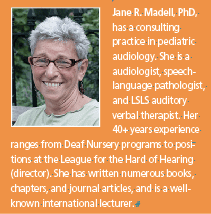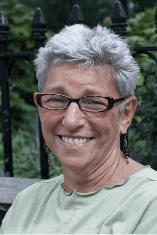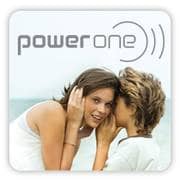Blog Page | October 2014 Hearing Review
This month’s Blog Page is an abridged version from the May 5, 2014 blog entry by Dr Jane Madell that can be found at her Hearing and Kids blog at http://hearinghealthmatters.org/hearingandkids — David Kirkwood, HearingHealthMatters editor
By Jane R. Madell, PhD

When I entered the hotel lobby, I was a little surprised to see a lot of deaf adults signing with voice off. It’s been a long time since I have seen that at a meeting. I expect a lot of signers at meetings like the National Association of the Deaf or similar organizations, but this meeting was primarily for issues relating to infants and preschoolers. I was surprised.
Big changes. I have been a pediatric audiologist for almost 50 years. Things have changed dramatically since I started. When I began, we fit little kids with body aids because the BTE models were so big we couldn’t get them to stay on the child’s head. The hearing aids we had worked well for kids with mild to moderate hearing loss, but not so well for kids with severe and profound hearing loss because they were just not very strong. In addition, there was a lot of distortion.
We’ve improved in at least three major areas since then. First, we have powerful hearing aids that provide sufficient gain to work for kids with severe hearing loss (HL), and are a good start for kids with profound HL until they get cochlear implants (CIs). We have FM systems, which we did not have when I got started, and, of course, we have CIs! We can now say that almost every child with hearing loss (and a cochlea) should be able to hear with appropriate technology.
Second, newborn hearing screening is identifying babies with hearing loss at birth. In the old days, we considered babies identified at 18 months to be early identified. Now the standard is that babies who fail newborn screening should receive a diagnostic evaluation by 3 months of age and begin intervention by 6 months (still too long!). Since babies are now identified early, they do not get “delayed.” We begin working with them immediately.
Finally, we now know that auditory brain development requires auditory access and only appropriately fit technology will permit this brain development. Children who use a visual mode first will not be able to fully develop their auditory skills at a later date.
How has all this changed parental decisions? Let’s remember that 95% of deaf kids are born to parents with normal hearing. They communicate using spoken language. When we ask parents what their goal is for their child, 85% of parents report that they would like their child to listen and talk. This is a big change from the situation before newborn hearing screening. Then about 40% of families chose sign language and the rest chose auditory-verbal, auditory-oral, or cued speech. It is clear that the world is changing. Many schools for deaf children are closing or becoming smaller as more children get mainstreamed. More and more parental support exists so families can have the energy and know-how to do what’s needed to help their children succeed.
What is the role for sign language? There is and always will be a place for sign language. It makes communication easier in noisy situations and when not wearing technology, but is it what we want as the primary communication mode for infants and children currently being identified with hearing loss? In my mind, parents who choose listening and spoken language are making the right decision. With the technology available today, deaf children can hear. Therapy is available to teach families how to help their children learn, and schools are helping children be successfully mainstreamed.
If deaf children can communicate using listening and spoken language the way their peers do, they have limitless opportunities. If they cannot, their choices are limited. Children who only sign have fewer employment choices and fewer social opportunities. The data is clear that children who learn sign first will not be as successful using listening and spoken language later because the auditory portion of the cortex will not develop as fully.
What upset me at the EDHI Conference? At the EDHI meeting, I saw a parent who was considering CIs surrounded by signing adults who were telling them they were going to damage their child by giving her an implant. (She was crying.) I heard one presenter report that it takes at least 2 years to learn to hear with a cochlear implant and that during this time the child will have no language. (This is definitely not true. Children start hearing when the CI is turned on, but just as with typical hearing children, it takes a lot of listening to learn to use the information.) I heard a presenter report that the only way a child can learn to read is through sign language. In fact, the average reading level for children who graduate from schools for the deaf is fourth grade.
Parents need correct information. Parents must make very difficult decisions when their child is identified with a hearing loss. They need to make an educated decision. Some choose listening and spoken language and others choose signing. But parents need to have honest information to make those decisions. I understand that there are people who believe strongly that signing is the appropriate method to educate deaf children. That is fine. They should explain to parents why they believe that signing is the right choice. But that information should be based on current evidence—not on what might have been true 20-30 years ago.
CHIME IN at: http://hearinghealthmatters.org/hearingandkids
Original citation for this article: Madell J. Parents of deaf children need accurate information. Hearing Review. 2014;21(10):12.





